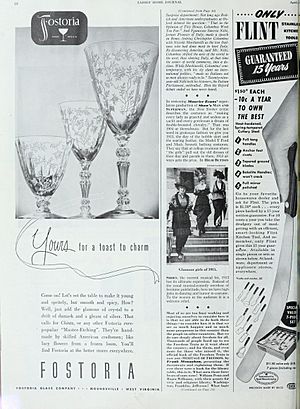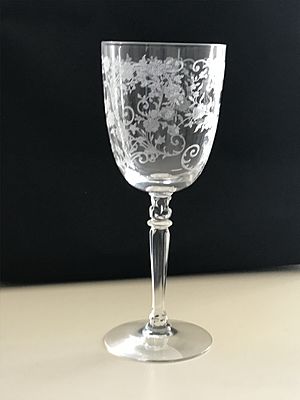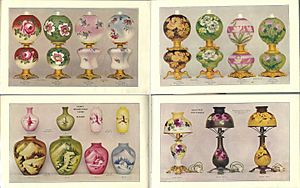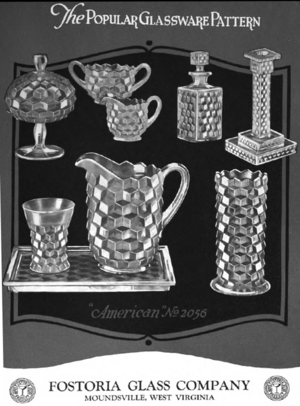Fostoria Glass Company facts for kids
 |
|
| Private company | |
| Industry | Glassware |
| Founded | December 15, 1887 in Fostoria, Ohio |
| Founder | Lucian B. Martin, William S. Brady |
| Defunct | 1986 |
| Headquarters | |
|
Key people
|
Lucian B. Martin, William S. Brady, Charles Foster, William A. B. Dalzell |
| Products | |
|
Number of employees
|
1000 (at peak in 1950) |
The Fostoria Glass Company was a famous company that made beautiful glass items. They created pressed, blown, and hand-molded glassware and tableware. The company started in Fostoria, Ohio, on December 15, 1887. The town even donated the land for the factory!
The company's founders were experienced glassmakers from West Virginia. They chose northwest Ohio because new discoveries of natural gas made it a perfect fuel for glassmaking. However, many other businesses also moved there. Soon, the natural gas supply ran out. Because of fuel shortages, the company had to move to Moundsville, West Virginia, in 1891.
After moving to Moundsville, Fostoria Glass became very well-known across the country. It was considered one of the best makers of "elegant glass." They created over 1,000 different designs. One famous design, called American, was made for over 75 years! The company even made glass for several U.S. presidents. At its busiest in 1950, Fostoria employed 1,000 people.
In the 1970s, the company faced tough competition from foreign companies. People's tastes also changed. Fostoria tried to update its factories with new machines to save money. But these changes came too late. By 1980, the company was losing money. The factory closed for good on February 28, 1986. Even after it closed, some other companies continued to make products using Fostoria's popular designs.
Contents
Starting the Glass Company
The Fostoria Glass Company officially began in West Virginia in July 1887. The founders were attracted to Fostoria, Ohio, because of the newly found natural gas. The town also gave them $5,000 to $6,000 to help them start.
The factory was built on South Vine Street in Fostoria. It was easy to transport goods because many railroads served the town. The factory's main furnace could hold 12 pots of glass. About 125 workers were hired at first. They started making tableware, bar items, and lamps on December 15, 1887.
The people who started Fostoria Glass learned their skills at the Hobbs, Brockunier and Company glass plant in Wheeling. Lucian B. Martin, the first president, was a sales expert there. William S. Brady, the company's secretary, managed money at Hobbs. James B. Russell and Benjamin M. Hildreth also worked at Hobbs. Otto Jaeger, who was from Germany, led the engraving team at Hobbs.
Former Ohio governor Charles Foster joined the company's board of directors. He was the son of the person Fostoria city was named after. Henry Humphreville became the plant manager. Many early employees came from the Wheeling area. Henry and Jacob Crimmel were important craftsmen. They brought their family's special glass recipes to Fostoria Glass.
First Glass Products
Fostoria Glass advertised that they made pressed glassware. Their special items included candle stands, candelabras, and banquet lamps. The very first piece of glass pressed at the factory was a small salt dish.
One popular early design was called Cascade. It looked like a swirl. This design was used for candelabras, ink wells, and tableware like sugar, cream, and butter dishes. Cascade was the first tableware design they made. It was so popular that it was used for many years under different names.
The company had many skilled designers. Charles E. Beam was in charge of the company's mold shop. He later joined the board of directors. Charles Beam was great at designing dishes with animal-shaped covers. One of his dolphin-covered dishes is highly valued by collectors today.
Company president Lucian Martin was also a talented designer. He patented the Cascade ink well in 1890. He also patented a paperweight with swirled sides in 1891.
The company's first Virginia design came out around Christmas in 1888. A rival company quickly copied this design. Fostoria Glass then copied the copy and called it Captain Kidd! This same design was later called Foster or Foster Block to honor Charles Foster. Advertisements for Captain Kidd showed butter dishes, spoon dishes, sugar bowls, and creamers.
Fostoria's Valencia design, number 205, is often called Artichoke. This is because of the overlapping leaves on the bottom of the glass. This design was advertised in a magazine in early 1891.
The Victoria design is very popular with collectors. Many different products were made with this design. It is the only design that the company patented. It looks a lot like a design from a French company. Fostoria Glass had some employees from France's glassmaking region. When the company moved to Moundsville, all the molds for the Victoria design mysteriously disappeared. They were never found, so the Victoria design was never made again.
Moving to Moundsville
The natural gas boom in northwest Ohio did not last long. Gas shortages started happening in the winter of 1890–91. In April 1891, Fostoria Glass leaders decided to move. They chose Moundsville, West Virginia, because it had plenty of coal for fuel. The community also offered them $10,000 in cash. Plus, they got a promise of a 10-year supply of coal at a low price.
The move was announced in September 1891. The Fostoria factory was sold to a group of investors. Otto Jaeger, a Fostoria Glass executive, led this group. His new company was named Seneca Glass Company.
In early December, the move to Moundsville was delayed. Some members of the Crimmel family, who owned stock in the company, filed a lawsuit. The Crimmels were also employees. They said that shareholders should have been asked about the move. But their attempt to stop the move failed. The company was able to move by the end of the month.
The company's first furnace in Moundsville could hold 14 pots. They didn't burn coal directly. Instead, the furnace burned coal gas made from the local coal supply. About 60 workers from the Fostoria factory moved with the company to Moundsville.
Glassmaking in Moundsville
In 1899, Fostoria Glass Company became connected with the National Glass Company. This was a large business group. Co-founder Lucien Martin left Fostoria in 1901 to work for National Glass. William Brady, another co-founder, also moved to the Pittsburgh firm soon after. Even with this connection, Fostoria Glass Company did not fully join the National Glass Company.
William A. B. Dalzell joined Fostoria as general manager in 1901. He was from Pittsburgh and had experience in the glass industry. Dalzell quickly became vice president. Under his leadership, Fostoria Glass Company became famous across the country. Dalzell served as president or chairman from 1902 until he passed away in 1928.
By 1903, the company already had two large furnaces. They added a new three-story brick building with another 14-pot furnace. One magazine said this made Fostoria "probably the largest independent flint glass concern in the country." By 1904, the company had 800 employees.
By 1906, they made many products. These included decorated lamps, globes, shades, blown and pressed tableware, high-quality lead blown tumblers, stemware, and fun new items. A magazine said that Fostoria "makes so many lines of glassware, all so perfectly, and markets its output so successfully... that no name is better known."
Moundsville Glass Products
Fostoria was known for making "elegant glass." They also made some Depression glass. The company had over 1,000 different designs. Many were created by artist George Sakier. For example, the Colony design was made from the 1930s until 1983. It was later reissued as Maypole using colored glass.
A "pattern" could be a style of glass, an etching (design carved into the glass), or a cutting (design cut into the glass). Some of Fostoria's most popular designs were American, Kashmir, June, Trojan, and Versailles. Design number 1861 was named Lincoln. This was the year Abraham Lincoln became President of the United States. This design was used for pressed tableware.
From the start in Moundsville until about 1915, Fostoria focused on oil lamps. They also made products for restaurants and bars, especially stemware and tumblers. In 1915, Fostoria introduced its American design (number 2056). This glass design was used for stemware and tableware. It was made until 1988. It looked "block geometric," which was very different at the time. Most American glass was made with Fostoria's high-quality crystal. American became Fostoria's most famous design.
Prohibition (when alcohol was illegal) reduced the need for barware. So, Fostoria focused more on tableware for homes. They aimed for the higher-quality home market first. In 1924, they were the first glass company to make full dinner sets in crystal. In 1925, they started making colored dinnerware. A national advertising campaign began in 1926 to promote these dinnerware sets. Fostoria also helped create the idea of the bridal registry. Clear and pastel dinner sets became very popular, even though they were expensive.
By 1926, the company had 10,000 different items in its catalog. Before the Great Depression, they had about 650 employees. In the 1920s, Fostoria introduced etching designs like June, Versailles, and Trojan. The June design was made from 1928 to 1951. It was etched on stemware and tableware. The Versailles design (1928-1943) was mostly on plates and dishes. The Trojan etching (1929-1943) was also on plates and dishes. By 1928, Fostoria was the biggest maker of handmade glass in the country.
Depression and After the War

During the Great Depression, the company made glassware for both expensive and affordable markets. Two popular Fostoria etching designs were Navarre and Chintz. Navarre was made from 1937 until 1980. It was etched on the Baroque glass design and other modern glass patterns. The Baroque glass design was made from 1937 to 1965. The Chintz design (1940-1973) featured branches, leaves, and flowers. It was usually on the Baroque glass design. The Colony design was also introduced around this time. Another long-lasting glass design, Century, was made from 1949 to 1982. It was used for stemware and tableware. Fostoria advertised in magazines like the Ladies Home Journal in the 1940s.
Production reached its highest point in 1950. Fostoria's 1,000 employees made over 8 million pieces of glass and crystal. High-quality products and national advertising helped the company remain the largest maker of handmade glassware in the United States. Every American president from Dwight D. Eisenhower to Ronald Reagan used glassware made by Fostoria.
Popular designs introduced in the 1950s included Rose, Wedding Ring, and Jamestown. Rose was a cutting on stemware and tableware (1951-1973). Wedding Ring was a decoration on stemware and tableware (1953-1975). Jamestown was a glass design for stemware and tableware (1958-1982). It came in crystal and seven colors: amber, blue, green, pink, amethyst, brown, and ruby. Collectors value the ruby Jamestown stemware the most.
In the 1960s and 1970s, the company started selling its products in boutiques and display rooms inside jewelry and department stores. In 1971, Fostoria's biggest customer was Marshall Field's. Marshall Field's had created the first bridal registry in 1935, which was very important for companies making tableware for homes. Fostoria also published its own magazine for customers, "Creating with Crystal." The Woodland glass design was introduced in 1975 and made until 1981.
Morgantown Glassware
In 1965, Fostoria bought the Morgantown Glassware Guild. This company was also known as Morgantown Glass Works. Morgantown was a leader in barware and also made tableware. First Lady Jacqueline Kennedy had chosen Morgantown glassware for the White House. Fostoria wanted to use this fame to sell more glass.
Glassware from Morgantown could be sold as stylish, affordable tableware for homes. However, this part of the business was only profitable for Fostoria for two years. Department stores stopped buying from secondary suppliers. Restaurants also started using machine-made glass instead. Fostoria closed the Morgantown factory in 1971.
Company Decline
In 1950, company president David B. Dalzell said Fostoria's competition came from other U.S. companies, imported goods, and automatic machines. In the 1970s, people's tastes changed. Also, many machine-made lead-crystal tableware items were imported. This forced Fostoria to invest a lot of money in new machinery.
This late attempt to use more machines made the workers uneasy. The company faced strikes in the early 1970s. By 1980, the company's business division was losing money.
In 1983, Fostoria sold its factory to Lancaster Colony Corporation. However, Lancaster Colony closed the Fostoria Glass factory for good on February 28, 1986. At that time, Kenneth B. Dalzell, a fourth-generation Dalzell, was in charge of Fostoria operations.
Dalzell later bought the assets of Viking Glass company in April 1987. He renamed it Dalzell-Viking. Fostoria's remaining glass items and molds were sold to several companies. Dalzell-Viking was one of them. The American, Baroque, and Coin designs were then made by other companies, including Dalzell-Viking. Some of this glassware made at Dalzell-Viking was created by former Fostoria employees using Fostoria molds. This makes it hard to tell them apart from glass made at the original Fostoria plant. Dalzell-Viking closed in 1998.
Images for kids







